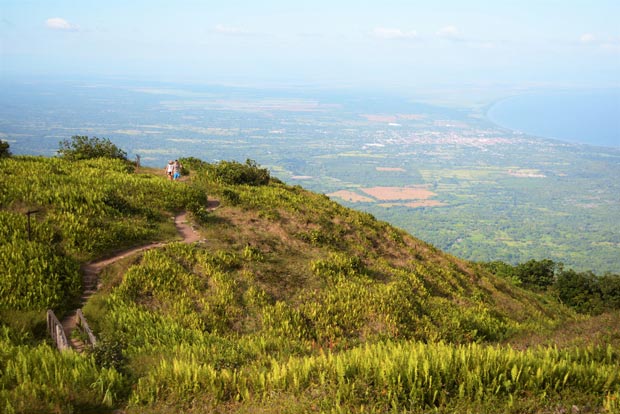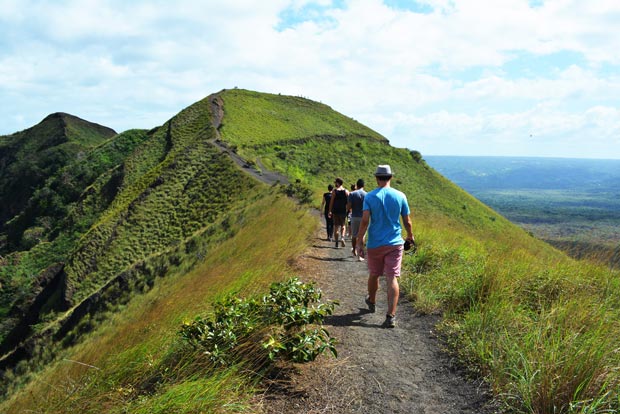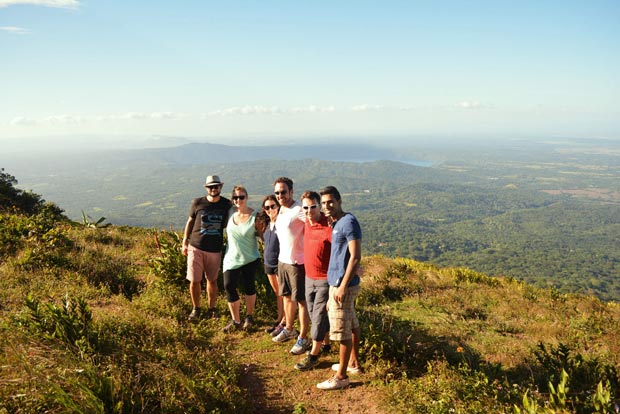Want to get up close to a volcano? Head to Nicaragua
I’ve always been fascinated by volcanoes, so Nicaragua was an obvious country to visit. Located between the Central American nations of Honduras and Costa Rica, Nicaragua is populated by some active or dormant volcanoes – the impressive Momotombo Volcano recently erupted in December 2015 and had lava running down its sides.

The Mombacho and Masaya volcanoes are the most accessible volcanoes to access from the Nicaraguan colonial city of Granada – an excellent base to see the country and about an hour south of the capital Managua.
Mombacho Volcano can be seen from most places across Granada, but its peak is often shrouded in cloud. You can get three-quarters of the way up Mombacho by a 4WD and then there are a couple of trails on the volcano.

The volcano is located only about a 15 to 20 minute drive from the centre of Granada. A taxi or tuk-tuk can get you there, but my group chose to do a tour with Tierra Tour up to Mombacho. The cost was $US30 ($NZ 42), which included transport, guide and entry into the Mombacho Volcano National Park. If you’re going it alone, the trail up to the starting point is not 2WD accessible all the way so you will have to walk up the steep road.
The easy trail to get your feet onto a volcano is a one-hour return trail through the jungle to take you part of the way onto Mombacho. There are some steps but it’s an easy walk. We were walking in the jungle for most of the trail until it opens onto a breathtaking lookout over Lake Nicaragua, Laguna de Apoyo and Granada. Laguna de Apoyo is a volcanic crater filled with water.
Along the way, our guide explained the plants we passed on the trail, and we also had a look into a few steaming vents on the volcano – standing above them is similar to the feeling of being in a sauna – they’re boiling and steamy. There’s also a tunnel on the trail that was formed by the rockface splitting apart during an earthquake.
While you don’t get to see any volcanic craters on the easy trail even though you’re right near them, it’s a good starting point to get your feet onto an active volcano and see great views of the local area.

There’s also a harder trail to the top of Mombacho. The Puma Trail is a difficult four hour return trail. A guide is essential to access this trail. The cost is $US55 ($A77), which includes transport, national park entry and the guide. On the way up to the Mombacho trails, there’s a coffee plantation owned by a local cooperative. You can sample the coffee at a little stall that also sells the plantation’s coffee beans.
Looking to get more up close and personal with an active volcanic crater – so close you can smell the sulphur? Then head to Masaya Volcano – about 30 minutes from Granada. Entry to the park is $US 4 ($NZ 5.60). The visitor centre at Masaya Volcano National Park has a great model to show the craters of the volcano.
The volcano used to be 1000 metres high until an eruption collapsed the crater and it now stands at around 600 metres tall. From the visitor centre, it’s about a five-minute drive up to the active crater. Along the way, you’ll have a chance to see the lava flow from the 1772 eruption.

Once you reach the top of the volcano, you can stand right up near one of the volcano’s craters emitting sulphurous smoke. On a good day, you’ll be able to see the sides of the crater. But some days, the sulphurous smoke dominates the area and it’s all you can see and it can be hard to breathe. It’s a good idea to bring something to cover your mouth and nose.
Heading up the hill on the left, you’ll spot another crater but this one is inactive and grown over, but it offers great views over to the active crater. Enclosed shoes are recommended to walk up to the second crater. It can get very hot in Nicaragua and the sides of the grassy crater are very steep and slippery with loose volcanic rock. But it’s only a short walk.
After sunset, you may even be able to see lava at the bottom of the crater if you’re lucky and there are night tours run by Granada tour operators. The cost of the trip is $US 35 ($NZ 50).
Also at the Mombacho Volcano, tours are available to have a look inside a lava tube.

You can walk right to the end of the lava tube, which extends about 500 metres, and is home to some animals including frogs, spiders and bats. Another activity at sunset is watching thousands of bats fly out of the lava tube.
Another volcano in Nicaragua that you can take a look at is Cerro Negro, located near the Nicaraguan city of Leon. Leon is located about a three-hour drive from Granada or two hours from the Nicaraguan capital of Managua. For an adrenaline rush, you can try volcano boarding on Cerro Negro – considered to be one of the most active volcanoes in Nicaragua.
Volcano boarding requires standing on a snowboard like board and heading straight down the sides of the volcano – reaching speeds of up to 70km an hour. You hike up one side and board down the other. The cost of the activity is $US35 ($NZ 50) starting from Leon. The cost includes equipment, transport, guide and a snack. There are also some tour operators in Leon running tours to hike up the Momotombo volcano if you dare!

Things you should know:
- Most tour operators in Nicaragua quote tour costs in US dollars and US dollars are readily accepted for payment.
- Enclosed shoes with good tread are recommended when heading out to visit any of the Nicaraguan volcanoes because of their slippery and sandy sides. Hiking boots may be needed if you’re planning to do one of the challenging volcano hikes offered.
- Take sunscreen, a hat and plenty of water when visiting volcanoes. While some parts of the volcanoes can be covered in jungle, other sections are very exposed, and it’s sweltering in Nicaragua.
- Shop around for volcano tours. There are many tour operators in Granada and Leon. Do some research to ensure the operator has a good reputation.
Lisa Owen is a pint-sized Australian following her dreams to travel to as many places as she can, and loves to share her photography, travel hacks, hiking adventures, and food discoveries along the way. At last count, she has travelled to more than 40 countries in between working in public relations and discovering hidden gems in Australia's great outdoors. Instagram: @_thelittleadventurer Facebook: The Little Adventurer Australia
The views, opinions and positions expressed by the author and those providing comments are theirs alone, and are meant as travel inspiration only. They do not reflect the opinions of Cover-More Insurance. You should always read the PDS available from your travel insurance provider to understand the limits, exclusions and conditions of your policy and to ensure any activities you undertake are covered by your policy.